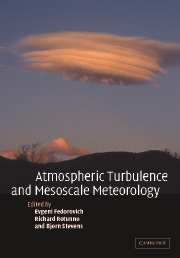Book contents
- Frontmatter
- Contents
- Preface
- Douglas K. Lilly: a biography
- Part I Atmospheric turbulence
- 1 Changing the face of small-scale meteorology
- 2 Phenomenological hunts in two-dimensional and stably stratified turbulence
- 3 Energy dissipation in large-eddy simulation: dependence on flow structure and effects of eigenvector alignments
- 4 Dreams of a stratocumulus sleeper
- 5 Large-eddy simulations of cloud-topped mixed layers
- Part II Mesoscale meteorology
- Appendix A Douglas K. Lilly: positions, awards, and students
- Appendix B List of publications by Douglas K. Lilly
- Index
- Plate section
1 - Changing the face of small-scale meteorology
Published online by Cambridge University Press: 04 August 2010
- Frontmatter
- Contents
- Preface
- Douglas K. Lilly: a biography
- Part I Atmospheric turbulence
- 1 Changing the face of small-scale meteorology
- 2 Phenomenological hunts in two-dimensional and stably stratified turbulence
- 3 Energy dissipation in large-eddy simulation: dependence on flow structure and effects of eigenvector alignments
- 4 Dreams of a stratocumulus sleeper
- 5 Large-eddy simulations of cloud-topped mixed layers
- Part II Mesoscale meteorology
- Appendix A Douglas K. Lilly: positions, awards, and students
- Appendix B List of publications by Douglas K. Lilly
- Index
- Plate section
Summary
The foundations of large-eddy simulation
The first example of what is today called large-eddy simulation, or LES, is generally taken to be Deardorff's (1970) calculation of turbulent channel flow. Considering it an application of an approach used by Smagorinsky et al. (1965) for calculation of the general circulation of the atmosphere, Deardorff referred to it by the less elegant term “three-dimensional numerical modeling.” He credited Lilly (1967) with determining its subgrid-model constants through Kolmogorov's (1941a, b) theory of the inertial subrange in three-dimensional turbulence.
Today LES is a dominant tool in turbulence research. Like our other turbulence tools it is imperfect, but it has provided a generation of researchers with insight into turbulence properties that are otherwise all but inaccessible, particularly in geophysical flows.
Frustration in the turbulence community
It is intriguing to view Lilly's early contributions to turbulence in the context of the community mood in the early 1960s. According to Moffatt (2002), a “sense of frustration” afflicted G. K. Batchelor and many others at that time:
These frustrations came to the surface at the nowlegendary meeting held in Marseille (1961) to mark the opening of the former Institut de Meacute;chanique Statistique de la Turbulence (Favre, 1962). This meeting, for which Batchelor was a key organizer, turned out to be a most remarkable event. Kolmogorov was there, together with Obukhov, Yaglom, and Millionshchikov … von Karman and G.I. Taylor were both there – the great father figures of prewar research on turbulence – and the place was humming with all the current stars of the subject – Stan Corrsin, John Lumley, Philip Saffman, Les Kovasznay, Bob Kraichnan, Ian Proudman, and George Batchelor himself, among many others.
- Type
- Chapter
- Information
- Atmospheric Turbulence and Mesoscale MeteorologyScientific Research Inspired by Doug Lilly, pp. 17 - 34Publisher: Cambridge University PressPrint publication year: 2004
- 6
- Cited by



